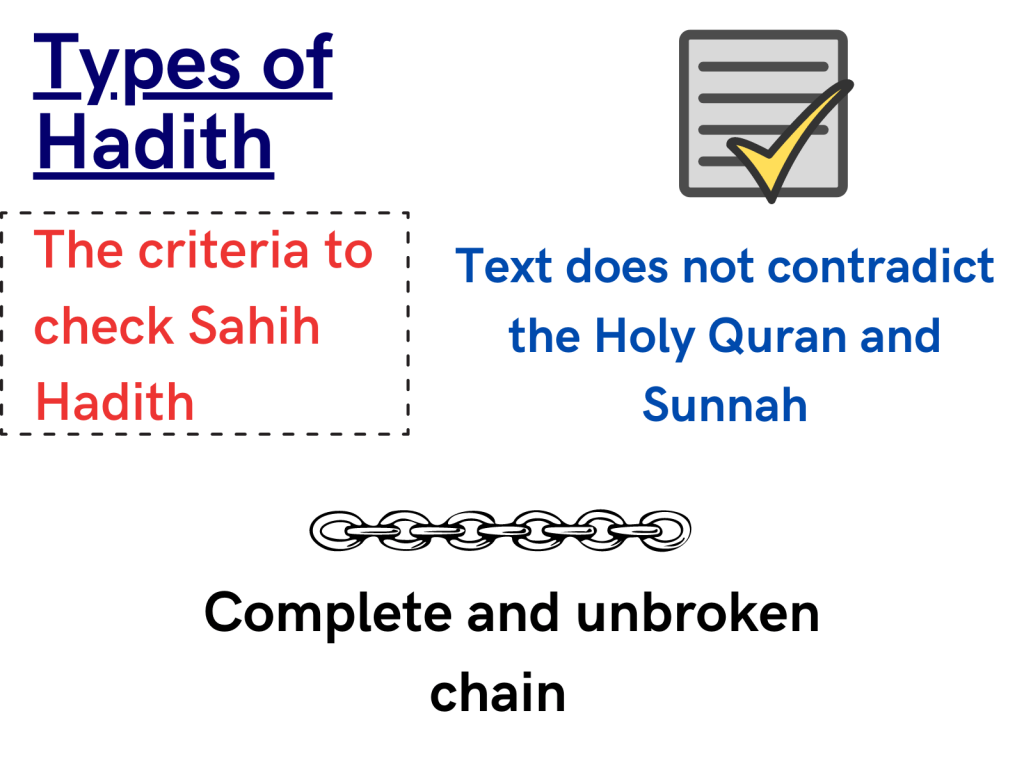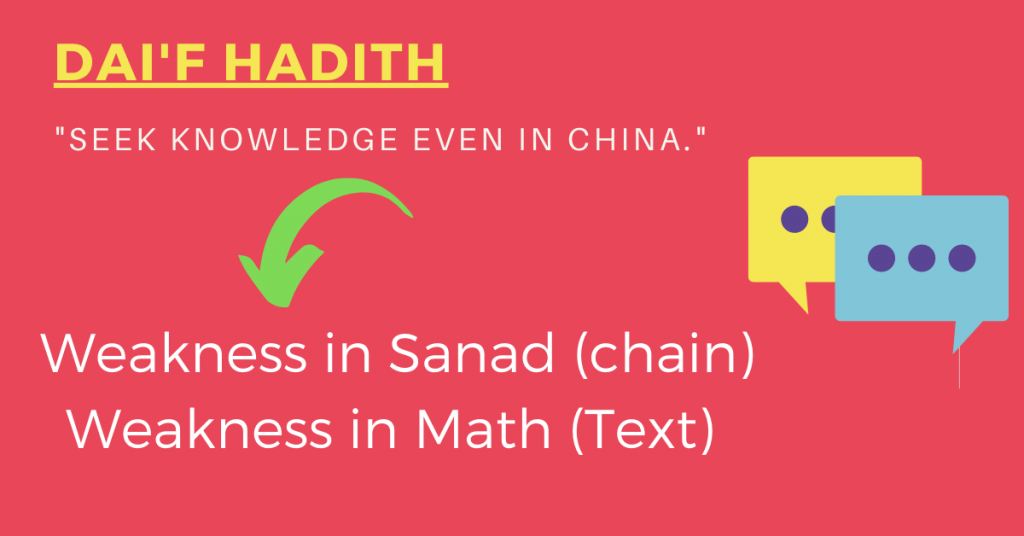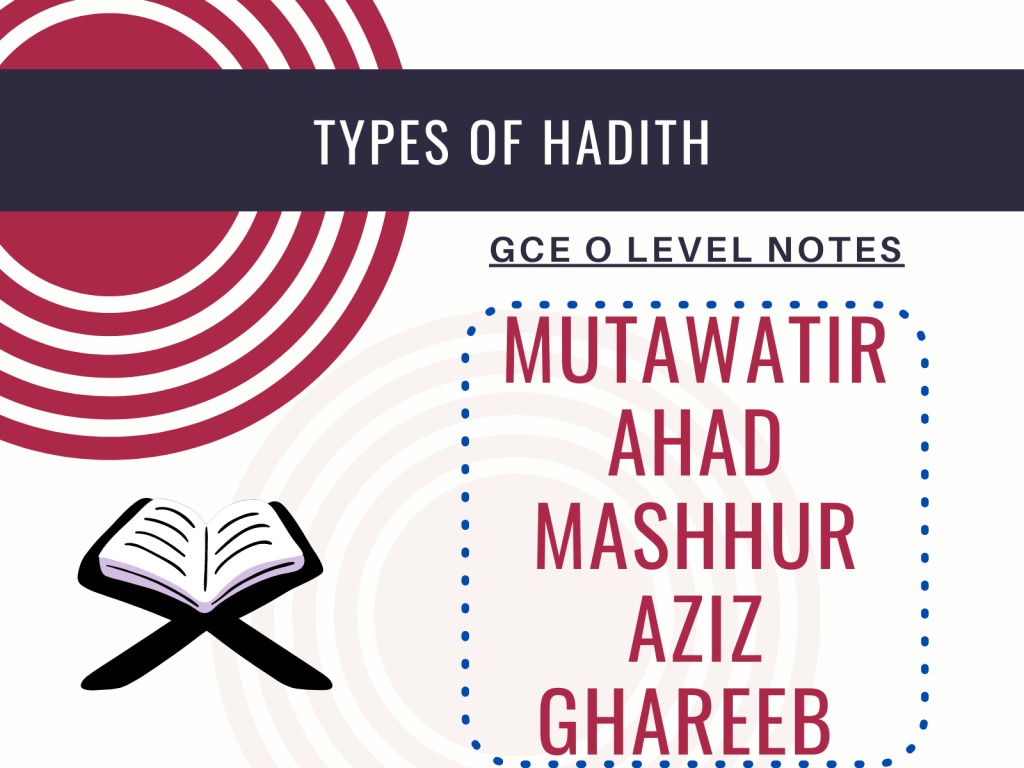In Islam, Hadith refers to the sayings and actions of the Holy Prophet (peace be upon him) and they are considered very significant because they contributed to the Islamic literature.
There are several types of Hadith that provide commandments, instructions and guidance to the Muslims in their life and in general about the Islamic principles.
The Ahadith of the Prophet Muhammad (peace be upon him) were compiled in book form, after his demise, by his followers.
This purpose was to ensure that the future generations were not deprived from the instructions given by the Holy Prophet (peace be upon him).
There are multiple types of Hadis such as :
- Sahih (Authentic or Reliable)
- Hassan (Approved)
- Dai’f (Weak)
- Mawdu (Fabricated)

Now when you know something about the topic, it is time to look at these types of Ahadith in detail now. So, let’s start without further introductions.
Note: The purpose of dividing the Ahadith Is to categorise them on the basis of their genuineness.
The Types of Hadith
Sahih Hadith:
This type of Hadith is the most authentic because the Matn (text) and the Sanad (the chain of transmitters) fulfil all the requirements that are required so that a Hadith can be considered reliable.
The chain of narrators is complete and unbroken and this type of Hadith is not contradicted by the Holy Quran and other authentic Ahadis.
What is Matn (text) and Sanad (chain of narrators) of a Hadith? If you are not completely sure about these two terms, do not worry because it is time to discuss them.
The Matn, the text of the Hadith, refers to the writing of the Hadith and it is also known as its “gist”.
The Sanad (plural Isnad) refers to the chain of narrators (reporters of the Ahadith) who reported the Hadith from the Holy Prophet (صلى الله عليه وسلم). In other words, these are the authorities who transmitted the sayings of the Holy Prophet (peace be upon him).
It is to note that the Sanad ended with a companion of Hazrat Muhammad (صلى الله عليه وسلم) because the companion reported the Hadith directly from the Prophet (peace be upon him).
The point about Matn and Isnad takes us to a very important topic which is, “how was the authenticity of a Hadith known?”.
The criteria to collect Sahih (Authentic) Ahadith:

The compilers of the Ahadith used different methods to ensure that the Ahadith collected were authentic.
When it comes to Sahih Hadith, how was it known that a Hadith was authentic (Sahih)? Let me explain you the complete method.
The Matn and Isnad were analysed to ensure the genuineness of a Hadith. The Matn was to fulfil the below-mentioned requirements in order to be considered reliable.
- Matn was to follow the Quranic injunctions
- It should not contradict other authentic Ahadith
- It should not attack the status of the Holy Prophet (peace be upon him)
- Easily understandable simple Arabic of the time of Prophet (صلى الله عليه وسلم)
- It should not go against the wisdom, laws of nature and common sense
These are some of the requirements that the collectors of Ahadith (Muhaditheen) used to check the text of a particular Hadith.
In the same way, there were several methods to check the genuineness of the Sanad as well. Some of these methods are discussed below.
The Sanad should be complete and unbroken and it should end on a companion who should have reported directly from the Holy Prophet (peace be upon him).
The chain was to be completely uninterrupted and according to Imam Bukhari, the birth and death dates of narrators should overlap.
The transmitter was to have flawless memory because a weak memory also challenged the authenticity of Hadith. The reports from non-Muslims, children and insane people were not to be accepted.

With this, I have explained some key points that you should know about how the authenticity of a Hadith was known and what criteria does a Sahih Hadith fulfils.
This takes us to another type of Hadith which is Hassan (approved) Hadith.
Hassan Hadith:
These types of Ahadith are similar to Sahih Hadith but there is some defect or weakness in the memory of one of its narrator.
These types of Hadith should not contradict the Holy Quran and the other authentic Ahadith of the Holy Prophet (peace be upon him).
There are several similarities between a Sahih and Hassan Hadith, some of them are:
- Narrators are trustworthy and pious in conduct
- The Sanad ends on a companion who reported directly from the Holy Prophet (صلى الله عليه وسلم)
- The text is understandable and it contains Arabic of the time of Prophet Muhammad (peace be upon him)
There is a weakness in the text as well sometimes in Hassan Hadith and we can understand that with the help of some examples.
Imam Tirmidhi says that the Hadith, “Paradise is under the shadow of swords” is a Hassan Hadith because Jafar bin Sualiman (one of its narrators) is not considered very reliable.
However, many other scholars consider this Hadith authentic.
Similarly, this Hadith that Amr bin Shoaib reported from his father who reported from his father (is a Hassan Hadith) that the messenger of Allah said:
A single rider is a devil, and a pair of riders are a pair of devils, but three are a company of riders.
Sunan Abu-Daud 2607
This chain includes grandson, father and grandfather but it is to note that this condition does not always make a Hadith Hassan.

Some scholars accept Hassan Ahadith while some reject this type of Hadith because of the weakness in memory of a narrator. However, some also considered it reliable on the basis of the text (Matn).
These examples can help you find out the reason why scholars are disputed on the authenticity of Hassan Ahadith. This takes us to Da’if (weak) Hadith which is also another type of Hadis.
Da’if (Weak) Hadith:
This type of Hadis is one that does not fulfil the criteria which is applied to check the authenticity and reliability of Ahadith.
In other words, a Dai’f Hadith does not meet the conditions (criteria) of a Sahih and Hassan Hadith. This type can either be weak in the text (Matn) or there might be some defect in the Sanad (chain of narrators).
There can be a severe defect in the character or the memory of a narrator which results in that Hadith being called “weak”.
Let me further elaborate this with the help of an example.
Abd Rahman bin Zaid bin Aslam, Abdullah ibn Lahi’ah (a popular judge from Hadith) and Abu Bakr bin Abi Maryam al-Himisi are some of the reporters of Hadith who does have extraordinary memory or character.
Therefore, if there is some weakness in the text reported by any of these narrators then, the Hadith may fall in the category of Dai’f.
When it comes to the ruling of the Dai’if Hadith, the scholars say that if the text does not oppose the Quran and Sunnah then, the commandments of the Hadith can be followed.
However, it is to note that the weak Ahadith do not contribute to the Islamic law (Shariah). It is time to conclude the topic about Dai’f Ahadith with the help of an example.
Seek knowledge even in China
This is a Dai’f Hadith in the eyes of many scholars but some scholars also say that it is “Hassan” due to the importance of education in Islam.
In short, a weak Hadith can have two major and serious defects in:
- Matn (Text)
- Sanad (chain of reporters)

It is time to introduce you to another category of Hadis, the Mawdu (fabricated) Hadis.
Mawdu Hadith:
A Hadith is said to be fabricated if the text goes against the teachings of the Holy Quran and Sunnah of Prophet Muhammad (peace be upon him) or the narrator is known to be a liar.
These Hadith may not fulfil the criteria which were applied to check the authenticity of Hadith. For example, the Hadith may oppose the laws of nature and wisdom which might make it “weak“.
There were several people (such as Muhammad ibn Sa’id al-Maslub) at that time in Arabia who themselves accepted the fabricating of Ahadith because they considered this act lawful.
There were multiple reasons why the Ahadith were fabricated such as:
- To create confusion about the teachings of the Quran
- Due to political, social and religious differences
- To manipulate the Islamic teachings for the future generations
It is to note that Muslims are prohibited to act upon the commandments of a Mawdu Hadith and this type of Hadith cannot be used to verify Islamic claims.
To explain this topic, let me quote a Mawdu Hadith:
Brinjal is the cure for all diseases and ailments
This is a Mawdu (fabricated) Hadith because the authenticity and reliability of the text and narrators cannot be verified.
Some other categories of Hadith:
There are several other categories of Ahadith but these are not required as per your syllabus but if you want to enhance your knowledge, you can continue the reading.
There types are:
- Mutawatir
- Ahad
- Mashhur
- Azeez
- Ghareeb

There are multiple chains of a “Mutawatir” Hadith and therefore, this type of Hadith is considered authentic because a large number of people report this Hadith.
The “Ahad Hadith” is the one which does not have a complete and unbroken chain and the reliability of this Hadith can be questioned. This Hadith can be accepted if the text does not contradict the Quran and the narrators have good conduct or memory.
The Mashhur Hadith is widely known and it also has several chains of narrators to support the text but this is not considered Mutawatir.
The Aziz Hadith is reported by two narrators in all stages while the Ghareeb is reported by only one narrator in all stages.
With this, the question arises that why was it important to compile the Ahadith? So let’s find out the answer to this question.
Why was it important to compile Ahadith?
It was important to compile Ahadith so that the commandments and teachings of the Holy Prophet (peace be upon him) were not lost.
Similarly, the Ahadith also serve the purpose of explaining the teachings of the Holy Quran (Tafsir) and therefore, it would have been difficult to understand Quran without the sayings of the Prophet Muhammad (peace be upon him).
The compilation ensured that categories (types) of Ahadith were made. As a result, the wrongdoers were prevented from attributing falsehood to the Holy Prophet (peace be upon him).
The compilation preserved the teachings of the messenger of Allah for the future generations and when massive Hadith literature was in circulation (after the demise of Hazrat Muhammad صلى الله عليه وسلم), it became mandatory to compile Ahadith.

These are some of the reasons why the Ahadith were compiled into many categories (to distinguish strong Hadith from the weaker ones).
The bottom line:
With this, the article about the categories or types of Hadith has come to an end.
The details required by the GCE O Level examination have been provided and extra details are also given to enhance your understanding about the topic.
I hope that all your queries have been answered but if you have further questions, you can use the comment section down below.
The different types of Hadis such as Sahih, Hassan, Dai’f and Mawdu are discussed above. Thank You very much for reading and staying with me till the end. Stay tuned for more.
